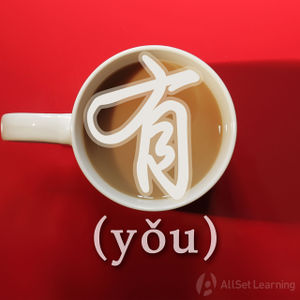Difference between revisions of "Taiwanese "you""
| Line 43: | Line 43: | ||
<div class="liju"> | <div class="liju"> | ||
| − | *我 <em>有</em> 吃 | + | *我 <em>有</em> 吃 ,吃 得 不 多 。<span class="trans">I have eaten, but I didn't eat a lot.</span> |
| − | *他 <em>有</em> | + | *他 <em>有</em> 说 ,但是 我 不 记得 了 。<span class="trans">He has told me your phone number.</span>*她 <em>有</em> 付 钱 吗 ?<span class="trans">Has she paid? </span> |
| − | * | + | *我 <em>有</em> 问 ,但是 他 不 告诉 我 。<span class="trans">I have asked, but he didn't tell me.</span> |
| − | * | ||
</div> | </div> | ||
Revision as of 04:15, 8 January 2018
-
Level
-
Similar to
-
Used for
-
Keywords
Taiwanese Mandarin differs slightly from Mainland Mandarin. A characteristic of Taiwanese Mandarin is the usage of 有.
Contents
Completed Verbs
In the Chinese language, there are verbs called “completed verbs.” These verbs are usually followed by a compliment, as they are not verbs that are ongoing. This is referring to the past tense.
Structure
Subj. + 有 + Verb + Obj.
Examples
- 你 有 说 错 这 句 话 。You said this sentence wrong.
- 老板 有 学 会 上海话 。The boss studied the Shanghai dialect.
- 我们 有 听 懂 你的 话 。I understood what you said.
- 我 有 看到 她 跟 你 前男友 在 一起。I saw her and your ex-boyfriend together.
- 我们 都 有 听到 宝宝 哭。We all heard the baby cry.
Action Verbs
There are also verbs categorized as “action verbs.” In Taiwanese Mandarin, when 有 is put in front of these verbs, it actually indicates that the verb is still continuing.
Structure
Subj. + 有 + Verb + Obj.
Examples
- 我 有 吃 ,吃 得 不 多 。I have eaten, but I didn't eat a lot.
- 他 有 说 ,但是 我 不 记得 了 。He has told me your phone number.*她 有 付 钱 吗 ?Has she paid?
- 我 有 问 ,但是 他 不 告诉 我 。I have asked, but he didn't tell me.
Adj. that follow 有 with 到
Adjectives can also follow 有. These adjectives are all in the past tense, with a 到 following the adjective.
Structure
Subj. + 有 + Adj. + 到
Examples
- 第一次 做 这么 多 运动,真的 有 累 到 。The first time I exercised so much, I was so tired.
- 他 突然 提出 跟 我 分手,我 真的 有 伤 到 。He asked to break up out of nowhere. I was so hurt.
- 你 买 了 那么 多 二手 家具,有 省 到 吗?You bought so many second-hand furniture. Does it save you a lot of money?
- 你们 突然 大叫 着 跑 出来,我 真的有 吓 到 !You guys suddenly came running out screaming loudly. I was so scared!
- 这 家 店 今天 全场 打 一 折,我 买 了 好 多,有 赚 到!Everything in this store is 90% off today. I bought a lot. It was so cheap!
Adj. not in the past tense using 有
Some adjectives can follow 有 and are not used as the past tense.
Structure
Subj. + 有 + Adj.
Examples
- 你 跟 你 妈妈 有 像 耶 !You and your mom look alike!
- 他 真的 有 生气 。He was really angry.
- 我 有 紧张 吗 ?Was I nervous?
- 她 当然 有 失望,你 又 忘了 她 的 生日 !Of course she was disappointed. You forgot her birthday again!
- 你 那么 大声 说话,我们 都 有 害怕 。We were all scared when you shout at us.
过 after the verb
Structure
Subj. + 有 + Verb + 过 + Obj.
Examples
- 我 有 去 过 中国 。I have been to China.
- 我 有 学 过 这 个 词 。I have studied this word.
- 你 有 见 过 那 个 人 吗?Have you seen that person before?
- 你 有 自己 做 过 饭 吗 ?Have you ever cooked for yourself?
- 你 有 看 过 这 个 电影 吗 ?Have you seen this movie?
在 after 有
In Standard Mandarin, using 在 before a verb is the equivalent to the English –ing. When used with 有 in front of it, it is usually referring to habitual action, or an action that can be stopped. This is not in the past tense, but rather a continuing action.
Structure
Subj. + 有 + 在 + Verb
Examples
- 那 时候 你 有 在 工作 吗?At that time, were you working?
- 这家 店 有 在 卖 小孩子的 衣服 吗?Is this store selling children’s clothes?
- 我 有 在 考虑 跟 她 分手 。I am considering breaking up with her.
- 我 妈妈 有 在 吃素 。 My mom is a vegetarian.
- 你的 学生 有 在 写 日记 吗? Do your students write diaries?
Sources and further reading
Books
- A Practical Chinese Grammar For Foreigners (外国人实用汉语语法) Anything Goes (无所不谈) →buy
- Chinese: An Essential Grammar, Second Edition (pp. 59-60) Anything Goes (无所不谈) →buy
- Chinese Grammar Without Tears (简明汉语语法学习手册) (pp. 73-4) Anything Goes (无所不谈) →buy
- Integrated Chinese: Level 1, Part 2 (3rd ed) (pp. 83- 4) Anything Goes (无所不谈) →buy
- Integrated Chinese: Level 2, Part 1 (pp. 345-7) Anything Goes (无所不谈) →buy
- Integrated Chinese: Level 2, Part 2 (pp. 49-51) Anything Goes (无所不谈) →buy
- Modern Mandarin Chinese Grammar: A Practical Guide (pp. 76-7, 230-2) Anything Goes (无所不谈) →buy
- New Practical Chinese Reader 2 (新实用汉语课本2) (pp. 175-6) Anything Goes (无所不谈) →buy
- 40 Lessons for Basic Chinese Course (基础汉语40课上册) (pp. 188) [ →buy]
Websites
- ChinesePod: Qing Wen - 过(guo) (free podcast content)
- [1]



